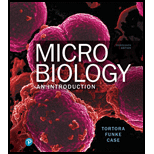
Between March 9 and April 12,five chronic peritoneal dialysis patients at one hospital became infected with Pseudomonas aeruginosa. Four patients developed peritonitis (inflammation of the abdominal cavity), and one developed a skin infection at the catheter insertion site. All patients with peritonitis had low-grade fever, cloudy peritoneal fluid, and abdominal pain. All patients had permanent indwelling peritoneal catheters, which the nurse wiped with gauze that had been soaked with an iodophor solution each time the catheter was connected to or disconnected from the machine tubing. Aliquots of the iodophor were transferred from stock bottles to small in-use bottles. Cultures from the dialysate concentrate and the internal areas of the dialysis machines were negative; iodophor from a small in-use plastic container yielded a pure culture of P. aeruginosa.
What improper technique led to this infection?
Want to see the full answer?
Check out a sample textbook solution
Chapter 7 Solutions
Microbiology: An Introduction (13th Edition)
Additional Science Textbook Solutions
SEELEY'S ANATOMY+PHYSIOLOGY
Laboratory Manual for Holes Human Anatomy & Physiology Fetal Pig Version
Human Anatomy & Physiology (11th Edition)
Concepts of Genetics (12th Edition)
Evolutionary Analysis (5th Edition)
- 1.) Why is boiling water not a recommended sterilization method? 2.) List examples of transfusion-transmitted infections. How are these infections prevented?arrow_forwardA 3-year-old severely ill child was admitted to a hospital withsymptoms of diarrhea, fever, and malaise. Laboratory testing showedabnormal renal and liver values and anemia. She had no history ofprevious illness, and her food history was a recent meal of teriyakibeef consumed at a local restaurant.a. What was the probable pathogen?b. What was the likely source?c. What is the pathologic effect of the pathogen?arrow_forwardAs an illustration, a patient undergoing a laparoscopic-assisted vaginal hysterectomy (LAVH) procedure under general anesthesia might be happier not to know the numbers of portals of entry for potential transmission of pathogenic microbes to which she will be subjected. The anesthesia provider would be accessing the patients airway and vascular system by an IV line. Which portals of entry will the surgeon be accessing?arrow_forward
- Cholera is most commonly transmitted through which route? A)Wound contamination 3)The bite of a tick 4)Fecally contaminated water 5)Close physical contactarrow_forwardWrite a 1-2 paragraph case study that accurately depicts the disease caused by Clostridium Botulinum. If your organism is transmitted in a specific location or under certain circumstances be sure your patient has been to those locations or engaged in those behaviors that would lead to transmission Have the appropriate timeline in terms of incubation and length of illness. Cover the important symptoms. You do not have to give all possible symptoms, just the typical one. Provide some important laboratory test results without stating the name of your microorganism. Provide the Epidemiology, Pathogenesis, Clinical Manifestations, Laboratory Tests, Treatment and Prevention.arrow_forwardIn the early 1900s, cities such as Philadelphia reduced the incidence of typhoid fever by: Question 1 options: A) isolating human carriers. B) using tertiary water treatment systems. C) filtering municipal drinking water through sand-bed filters. D) requiring residents to boil drinking water.arrow_forward
- The most common preferred portal(s) of entry for human pathogens is (are): 1. Mucous membranes of the genitourinary tract 2. Mucous membranes of the respiratory & gastrointestinal tracts 3. Conjunctival membranes of the eyes 4. Intact skin 5. Parenteral routearrow_forwardPlease refer to the given scenario below. What is the most appropriate sample to be collected to isolate the causative agent of the infection? * A 46-year-old male encountered a motor-vehicular accident (MVA) resulting in multiple injuries on his anterior chest and left lower extremities. Aside from the injury, his medical history was unremarkable. The patient was admitted for nine days and underwent debridement and was discharged with an external fixator. However, during his admission, on his 7m post-operative day, the wound was noted to have persistent purulent, bloody discharge from drain site, which is highly suggestive of surgical site infection (SSI). Whole blood Debridement Serum Discharge from drain sitearrow_forwardWhich of the following is NOT true of bacterial exotoxins? 1. Important in the pathogenesis of many human diseases 2. Their toxic effect can be systemic, affecting cells distant from the primary site of infection 3. None of the other four answers (All are true of bacterial exotoxins) 4. Different exotoxins may affect different types of cells (e.g., nerves, gastrointestinal mucosa) 5. Some exotoxins have two components, A (active) and B (binding)arrow_forward
- Every employee, nurses, doctors and others who are in direct contact with any patients hospitals or in doctors chambers must adhere to infection control policies and procedures. Question options: A) True B) Falsearrow_forwardA group of patients entered the hospital unconscious. All patients are employees of a chemical plant, where mass poisoning with cyanide compounds occurred. Questions: 1. The development of which kind of typical pathological process (TPP) is initiated by intoxication with cyanides? 2. Define this TPP. 3. What kind of TPP according to the pathogenetic classification has developed in patients? 4. Describe the mechanism of formation of this type of TPP. 5. List the changes in blood gas composition and pH at this form of TPP. 6. How can you explain these changes in blood gas composition and pH? 7. What kind of tissue cell death is typical in this case?arrow_forwardWhich statement made by the patient newly diagnosed with systemic lupus erythematosus indicates a need for further teaching about the course and management of this disease? a) "I will take my medication even if my symptoms improve." Ob) "I will not have my hair dyed, frosted, or permed unless I am in a period of remission." Oc) "I will report any fever to my healthcare provider immediately." d) "I will sunbathe as often as possible to ensure I get enough vitamin D."arrow_forward
 Microbiology for Surgical Technologists (MindTap ...BiologyISBN:9781111306663Author:Margaret Rodriguez, Paul PricePublisher:Cengage Learning
Microbiology for Surgical Technologists (MindTap ...BiologyISBN:9781111306663Author:Margaret Rodriguez, Paul PricePublisher:Cengage Learning
